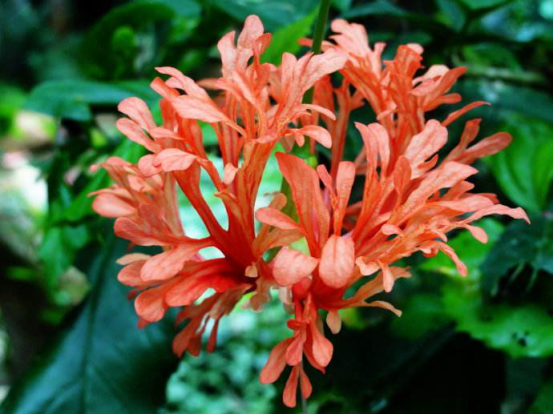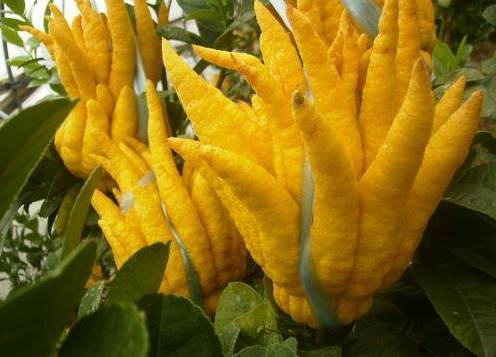Culture methods of pomegranate flowers
Planting
When planting pomegranate flowers, it is best to choose to plant in spring, choose a high-quality seedling with complete root system and full bud eyes, plant it deeply in a clay basin, apply a certain amount of base fertilizer, and maintain it in the sun.

Temperature
The suitable environment for pomegranate flower growth is warm and humid environment, the most suitable growth temperature is 15-20 ℃, and it is best to be cultured indoors in winter.
Watering
Pomegranate flowers are resistant to drought and waterlogging, so we should pay attention to timely drainage in peacetime maintenance to prevent poor plant growth caused by too much watering. Of course, in the sprouting period, fruit expansion period and before defoliation, attention should be paid to watering in these three periods to ensure that the soil is moist and does not accumulate water.
Fertilizer application
Pomegranate flowers need to apply more fertilizer at the beginning of planting, and an appropriate amount of urea can be added to the fertilizer. Pay attention to keep the fertilizer away from the rhizome when fertilizing so as not to burn the root. In addition, in the growing season, it is necessary to apply fertilizer in time according to the growth of the plant and increase phosphorus and potassium fertilizer in time.
In addition, in the process of planting, we must know the following points for attention in order to make pomegranate flowers grow better!
Culture methods of pomegranate flowers
Pomegranate flower, native to Central Asia, was introduced into China in the Han Dynasty. It is a kind of plant with objective visible fruit. The fruit is pomegranate, which is a delicious fruit. Pomegranate flowers grow on pomegranate trees, generally about 3m high, the trunk is generally grayish brown, the leaves are yellowish green, pomegranate flowers are more opposite or clustered, and the flowers are generally born at the top of the tree and are fleshy flowers. The surface is dominated by waxy flowers, usually orange. With the development of planting technology, dwarf pomegranate trees are gradually transplanted to family planting. And the pomegranate flower can not only bear fruit and eat, but also can be used as medicine and edible. Pomegranate trees decorate the home in the form of potted plants, with bright and beautiful flowers, blooming in summer, and the whole pomegranate tree is generous. Summer can also bear fruit, is a rare practical, but also ornamental flowers. So since the pomegranate flowers are so good, how to grow them? First of all, we need to understand his habits.
Pomegranate flowers are widely distributed, and they are cultivated in many places, and can also be cultivated in many soils and environments. Generally speaking, pomegranates cultivated in courtyards or dwarfs can also be cultivated in pots. The life span is relatively long, if properly cultivated, it can live for decades, and in some tropical rain forests, pomegranate trees can grow for more than 200 years. As an evergreen fruit tree, pomegranate flowers like light, only need to give enough water, can grow well in time under the strong light. As pomegranate trees are also planted in the north, their drought tolerance is still relatively strong. Generally, the best breeding method is semi-cultivated and semi-wild, and the general soil can grow, as long as the annual temperature is not less than 10 degrees Celsius, then the leaves will fall off and will join hibernation, and the summer temperature is very suitable for growth. so pomegranate trees bloom better in summer. Pomegranate trees generally sprout in early spring, and then begin to grow branches and leaves, generally grow faster in summer, but generally impossible to blossom in the first year, generally blossom more in the second year, and then bear fruit, and then grow larger in three years.
How to grow pomegranate flowers
1. Illumination: pomegranate flowers are sunny plants, the best sunshine time is 12 hours a day, because pomegranate trees need sufficient light if they want to grow up. Generally, the exuberant sunshine in summer is the best storage period for autumn fruit. The better the sunshine is, the bigger the flower is, the better the fruit is.
2. Moisture: Garnet can be fed in many parts of the country and can be fed in some dry places, so pomegranate is a drought-tolerant breed. However, in general, the flowers of pomegranate trees grown in this place are not bright, and the fruit is not delicious. This also proves that if you want to cultivate pomegranate trees well, it is recommended to give enough water.
3. Soil: pomegranate trees have the lowest requirements for soil, and generally natural soil can be planted, but potted pomegranates suggest that the soil still needs to be a little more fertile.
4. Temperature: pomegranate flowers like to be warm, so they grow fastest in late spring and summer, but the general temperature should not be less than 10 degrees Celsius during the winter, otherwise the pomegranate trees will suffer frostbite and stop growing and go into dormancy.
Culture method of pomegranate flower how to raise pomegranate flower
Pomegranate flowers are often used as an ornamental because of their beautiful flowers. when the flowers are full of red flowers, they bloom with dazzling beauty. small pomegranate pots can be placed on windowsills, balconies and bedrooms. How to grow pomegranate flowers? Let's take a look at the cultivation of pomegranate flowers.
First, how to grow pomegranate flowers
Pomegranate flowers are commonly used in cutting, ramet and striping propagation. For cuttings, biennial branches can be selected in spring or semi-lignified branches in summer, which can take root 15-20 days after cutting. Ramet, when the bud germinates in early spring, the strong root tiller seedlings can be dug up and planted separately.
Striping can be carried out in spring and autumn without scratching. Before bud germination, some tillering branches of the root are pressed into the soil, and the mother plant is cut off after taking root in summer, and the seedling is formed in autumn.
Open field cultivation should choose places with sufficient light and good drainage. In the process of growth, it is necessary to remove roots and tillering seedlings and cut off dead branches, diseased branches, dense branches and overgrown branches to facilitate ventilation and light. Potted plants should be planted shallowly, watering should be controlled, dry rather than wet. During the growing period, it is necessary to pick the heart, control the growth of vegetative branches and promote the formation of flower buds.
II. Culture methods of pomegranate flowers
1. Planting: pomegranate planting can be carried out all the year round, especially in early spring and autumn. It is said that it is planted in spring in the north and autumn in the south. It is appropriate to select high-quality seedlings with complete root system, full bud eyes and smooth stem, which can stir the soil until it is mature, remove sundries, change new soil, dig to 50 cm, bury it deeply, its length up to 0.6-0.8 meters, and apply 25-50 kilograms of organic fertilizer, which is fully mixed with topsoil and backfilled.
2. Moisture: there is irrigation and drainage, that is, the pomegranate needs to be irrigated during the critical period, and the soil moisture should be 60-80%, and it should also be flexibly controlled in other periods. These three key periods are budding stage, fruit expansion stage and pre-defoliation stage. Because pomegranate is resistant to drought and waterlogging, it is also necessary to pay attention to drainage treatment to prevent poor growth of pomegranate caused by waterlogging.
3. Fertilization: additional fertilizer is needed in the year of planting, and 1-2kg of cooked manure water plus a small amount of urea is applied to the soil. Autumn leaves also need to be fertilized, the general practice is to dig a good ring ditch, topdressing 20kg to 30kg. Fertilization is also needed in the full fruit period, and the rotten manure water is applied in Shupan hole for 3 times for 4 times. It is also necessary to pay attention to topdressing in the growing season, which is usually dominated by nitrogen fertilizer, followed by phosphorus and potassium fertilizer, and pay attention to controlling the concentration of fertilizer.
4. Pruning: pomegranate likes light, so considering its light transmission performance, of course, we should also pay attention to ornamental. Therefore, attention should be paid to ensuring a certain shape when shaping and pruning. For example, natural happy shape, V shape and so on. The principle of pomegranate pruning is: visible never die, invisible do not know chaos. Therefore, these branches and leaves should be carried out in accordance with this principle, so as to make their strong branches have room to grow, while no use of space should be dealt with in time.
The above is the introduction of pomegranate flower culture methods, hoping to help you better cultivate pomegranate flowers, so that friends who love pomegranate flowers can see the beauty of pomegranate flowers blooming.
Recommended reading:
What is ① pomegranate flower language? what is the symbolic meaning of pomegranate flower?
How do ② pomegranate flowers grow? when will pomegranate flowers bloom?
③ June snow culture methods and matters needing attention (must see)
Planting methods of ④ roses sharing of Rose Propagation methods
Culture methods and matters needing attention of ⑤ Tulip
- Prev

Cultivation method of potted household chandelier hibiscus
1, soil hanging lamp Fusang planting soil should be selected loose, fertile sandy loam, every early spring should be changed pots, change pots should be prepared before the new soil, cut off part of the dense curly fibrous roots, and apply sufficient root fertilizer. 2. The growth habit of the chandelier requires it to receive sufficient sunlight
- Next

The mode of reproduction of bergamot
1. Cutting is usually carried out in spring and summer. Before cutting, the well-developed branches should be selected, cut into several segments, then dry for two days, and then be inserted into the soil after the wound heals, and then take good care of them and wait for them to take root. 2. Grafting is divided into cutting method and leaning grafting method.
Related
- Fuxing push coffee new agricultural production and marketing class: lack of small-scale processing plants
- Jujube rice field leisure farm deep ploughing Yilan for five years to create a space for organic food and play
- Nongyu Farm-A trial of organic papaya for brave women with advanced technology
- Four points for attention in the prevention and control of diseases and insect pests of edible fungi
- How to add nutrient solution to Edible Fungi
- Is there any good way to control edible fungus mites?
- Open Inoculation Technology of Edible Fungi
- Is there any clever way to use fertilizer for edible fungus in winter?
- What agents are used to kill the pathogens of edible fungi in the mushroom shed?
- Rapid drying of Edible Fungi

